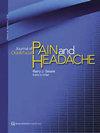Features of Neurovascular Orofacial Pain Compared to Painful Posttraumatic Trigeminal Neuropathy.
IF 1.9
3区 医学
Q2 DENTISTRY, ORAL SURGERY & MEDICINE
引用次数: 10
Abstract
AIMS To test and re-examine the diagnostic criteria for neurovascular orofacial pain (NVOP) compared to posttraumatic trigeminal neuropathy (PTTN). METHODS Pain and patient characteristics were compared in patients with NVOP, PTTN, and NVOP initiated by trauma (PT-NVOP). NVOP criteria were based on prior studies, and PTTN was defined according to the International Classification of Headache Disorders, version 3 beta. RESULTS Of the 170 patients in the cohort, 90 had PTTN, 51 had NVOP, and 29 had PT-NVOP. None of the tested parameters in the NVOP and PT-NVOP patients were significantly different, and therefore these patients were combined into one group (T-NVOP). T-NVOP differed significantly from PTTN (P < .001) in periodic pain patterns, presence of autonomic and systemic signs, throbbing pain quality, and frequency of bilaterality. Pain quality in PTTN was more burning/stabbing than in NVOP (P = .003). Pain severity, waking from sleep, muscle sensitivity to palpation, and demographics were comparable. CONCLUSION NVOP differs from PTTN in parameters essential to diagnosis: periodicity of pain, presence of autonomic and systemic accompanying signs, throbbing pain quality, and bilateral presentation. NVOP is amenable to abortive and prophylactic antimigraine therapies, distinguishing NVOP from PTTN in clinical features, treatment, and prognosis.神经血管性口面部疼痛与创伤后疼痛性三叉神经病变的特征比较。
目的探讨神经血管性口面痛(NVOP)与创伤后三叉神经病变(PTTN)的诊断标准。方法比较NVOP、PTTN和外伤引发的NVOP (PT-NVOP)患者的西班牙和患者特征。NVOP的标准是基于先前的研究,而PTTN是根据国际头痛疾病分类第3版beta版定义的。结果170例患者中,90例为PTTN, 51例为NVOP, 29例为PT-NVOP。NVOP和PT-NVOP患者的各项检测参数均无显著差异,故将其合并为一组(T-NVOP)。T-NVOP与PTTN在周期性疼痛模式、自主神经和全身体征、悸动疼痛质量和双侧频率方面有显著差异(P < 0.001)。PTTN患者的疼痛质量比NVOP患者更灼烧/刺痛(P = 0.003)。疼痛严重程度,从睡眠中醒来,肌肉触诊敏感性和人口统计学具有可比性。结论nvop与PTTN的诊断参数不同:疼痛的周期性、自主和全身伴随症状、悸动性疼痛的质量和双侧表现。NVOP可接受流产和预防性抗偏头痛治疗,在临床特征、治疗和预后上将NVOP与PTTN区分开来。
本文章由计算机程序翻译,如有差异,请以英文原文为准。
求助全文
约1分钟内获得全文
求助全文
来源期刊

Journal of Oral & Facial Pain and Headache
DENTISTRY, ORAL SURGERY & MEDICINE-
CiteScore
5.10
自引率
4.00%
发文量
18
期刊介绍:
Founded upon sound scientific principles, this journal continues to make important contributions that strongly influence the work of dental and medical professionals involved in treating oral and facial pain, including temporomandibular disorders, and headache. In addition to providing timely scientific research and clinical articles, the journal presents diagnostic techniques and treatment therapies for oral and facial pain, headache, mandibular dysfunction, and occlusion and covers pharmacology, physical therapy, surgery, and other pain-management methods.
 求助内容:
求助内容: 应助结果提醒方式:
应助结果提醒方式:


